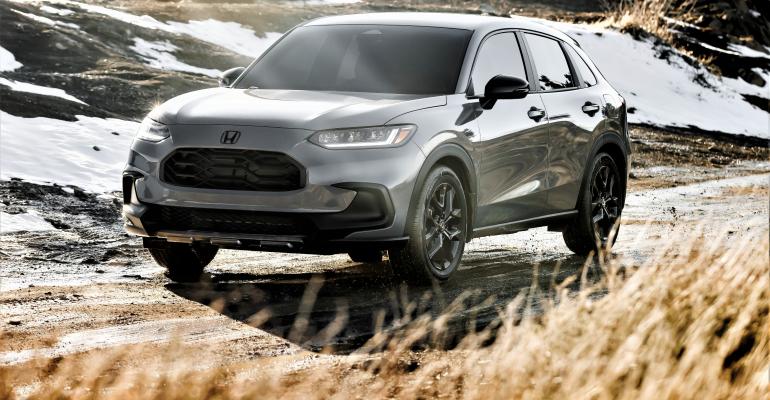STEVENSON, WA – Honda’s HR-V entry-level CUV has been a competitive contender but has played little sister to its larger, more mature and much stronger-selling CR-V sibling. That made sense because it was based on Honda’s smaller, less-expensive Fit, while the CR-V is Civic-based.
But for 2023, HR-V moves up to the ’22 Civic’s global architecture platform and so grows in size, performance, features and appeal. Now powered by the Civic’s 158-hp 2.0L 4-cyl. (vs. the previous 141-hp 1.8L) that delivers 138 lb.-ft. (187 Nm) of peak torque through a “re-engineered” CVT, it also boasts a roomier interior on a longer 104.5-in. (2,654 mm) (up 1.7 ins. [43-mm]) wheelbase, significantly wider tracks (+ 2.0 ins. [51 mm] front, 2.5 ins. [64 mm]) rear) and independent rear suspension.
Among its other key features are standard Hill Descent Control, a 7.0-in. (18-cm) multi-information display, a 7.0-in. – or available 9.0-in. (23-cm) HD – color touchscreen with Apple CarPlay and Android Auto compatibility (wireless with the latter), Honda Sensing system with new wide-view front camera, Traffic Jam Assist, Traffic Sign Recognition and available Real Time AWD with Intelligent Control.
The more upscale-looking base HR-V LX has a matte-finish honeycomb grille and lower bumper surfaces and 17-in. silver-painted alloy wheels. HR-V Sport gets a more aggressive, horizontal-themed grille mesh, a gloss-black rear spoiler, a chrome exhaust finisher, a gunmetal metallic lower rear bumper and exclusive 18-in. gloss-black, five-spoke wheels. EX-L wears a gloss-black version of the honeycomb grille and gloss-black door pillars and bumper trim and rolls on machined-finish gray 17-in. alloys.
Outward visibility from its all-new cabin is better with a lower cowl, larger glass areas and outside mirrors mounted away from the windshield pillars. A metal honeycomb mesh stretching across the dash separates audio and information displays from climate controls and houses the air vents. Premium materials give an upscale look echoed by precise operation of all switches and controls. The upholstered center console’s pass-through houses two USB ports and handy storage for a phone and other small items.
New “Body Stabilizing” seats are said to enhance comfort and reduce fatigue on long drives (they worked well for us), and the rear seat area is wider with more legroom than before. Cargo space behind the back seats is bigger at 24.4 cu.-ft. (691 L), has a low lift-over height to ease loading and expands to 55.1 cu.-ft. (1,560 L) with the 60/40 rear seatbacks folded flat.

Inside (pictured, above), a 7.0-in. color LCD instrument display has a tachometer, both digital and analog speedometers and selectable Honda Sensing settings, vehicle information and more. A 7.0-in. central color touchscreen – with welcome volume and tuning knobs and buttons along the bottom for switching modes – is standard on LX and Sport. The top EX-L trim gets a 9.0-in. touchscreen plus a wireless phone-charging pad and upgraded 8-speaker audio with the volume knob but no tune/scroll knob, Home and Back hard buttons and simplified navigation and mode selections along the bottom.
Driving Impressions
The 2023 HR-V’s stronger structure and a new independent rear suspension make it notably smoother on chunky surfaces and more athletic on twisty two-lanes. Like the ’22 Civic (which was voted North American Car of the Year), its handling is impressively agile – it’s essentially a taller Civic – while its steering delivers good feel and improved straight-line stability and its larger brakes (with new low-drag calipers) give strong, linear stopping power. Performance from its 2.0L 4-cyl. feels adequately eager at low speeds, but – partly due to the CVT – it’s too sluggish when passing slower vehicles.
The ’23 HR-V offers three selectable drive modes: Normal, Eco and a new Snow mode that alters throttle mapping and drive ratios to optimize slick-road traction. Our dry road drives did not provide a chance to test that, its newly standard Hill Descent Control or its re-tuned available real-time AWD in slippery conditions, so those impressions will have to wait.
We averaged 23.3 mpg (10.1 L/100 km) on our (mostly aggressive) two-lane morning drive and 28.8 mpg (8.2 L/100/km) on our tamer afternoon drive, about half of which was on an Oregon interstate.
On the safety front, its Advanced Compatibility Engineering architecture is designed to meet all present and anticipated future crash requirements while minimizing added weight. Front knee and rear side-impact airbags are newly standard, and the HR-V’s new single-camera Honda Sensing suite of safety and driver assist systems gives a 100-degree field of view.
The view is twice as wide as the previous system’s camera-and-radar setup and recognizes not just white lines but also road boundaries, other vehicles, road signs, pedestrians and bicyclists. Other new features include a Driver Attention Monitor and a Rear Seat Reminder that notifies drivers when exiting the car to check in back for children, pets or other precious cargo.
Except for the lack of a tune/scroll knob, we found its infotainment interface easy and intuitive to use. Additional driver-assist technologies include blindspot information for the first time and four sonar sensors on the front and rear bumpers of EX-L models that enable Low-Speed Braking Control and front and rear false-start prevention to help avoid low-speed collisions.
In addition, the responses of such existing features as Adaptive Cruise Control with Low-Speed Follow and Lane Keeping Assist are fine-tuned to feel more natural than before, and we found them very effective.
With $25,000-$30,000 stickers and EPA economy in the 25-mpg city (9.4 L/100 km) to 32-mpg (7.3 L/100 km) highway range, this new larger, more-feature-loaded (but pricier) HR-V looks to be a stronger segment competitor than the one it replaces.
And, aside from needing more midrange performance (maybe a future turbo version?), our only major gripe was the lack of a 12V plug for dashtop accessories – just the second vehicle we’ve ever encountered without that still-important feature (the other was a new Silverado ZR2). We’re hoping this is not an unfortunate trend.





